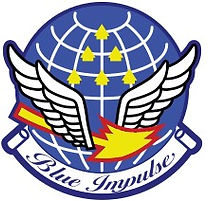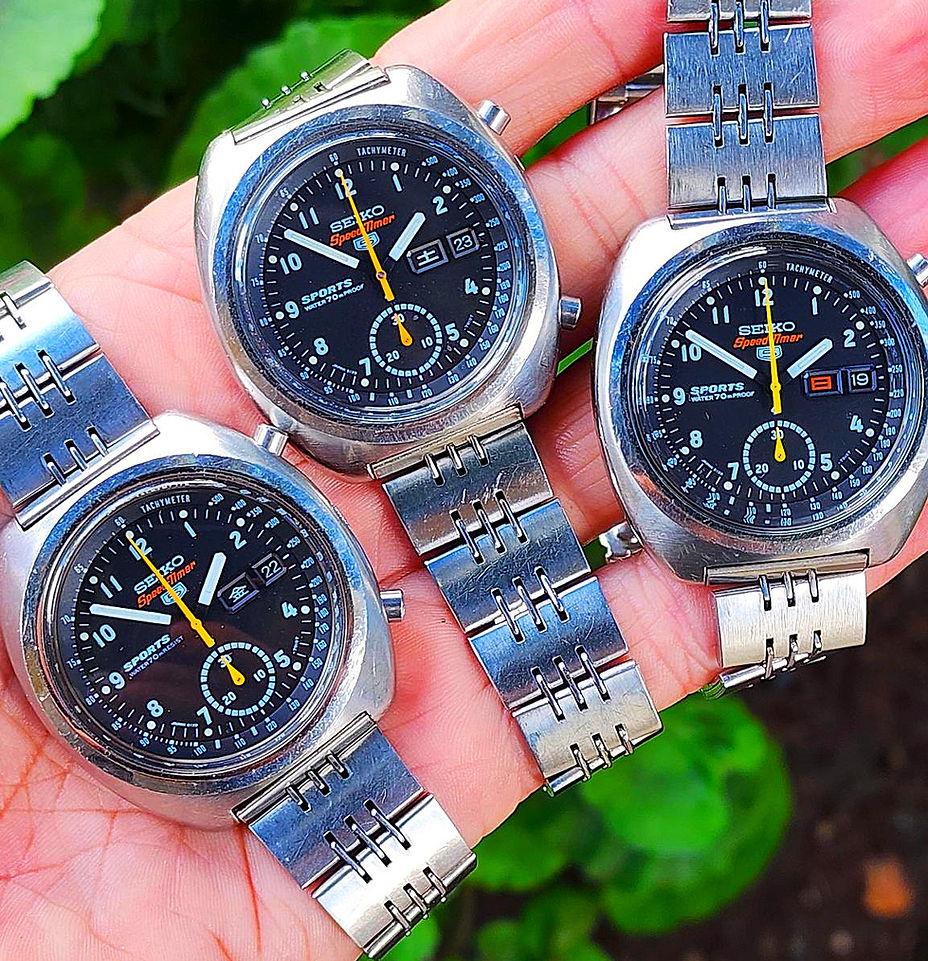The Seiko 6139-7012 Chronograph
Issued to Cold War Jet Fighter Pilots

A Seiko 6139-7010 automatic chronograph, issued by the Japanese Air Self-Defense Force (Photo Credit: DC Vintage Watches)
It’s been more than half a century since the debut of the world’s first automatic chronograph, Seiko’s Ref. 6139, in early 1969. With its dozens of variants, it’s inevitable the watch would find its way onto the wrists of numerous adventurers – Formula 1 (François Cevert) and Japanese racers Le Mans (Tetsu Ikuzawa), NASA astronauts (William Pogue and Richard O'Covey), sailing innovators (Bram Dally), actors (Al Pacino, Daniel Dae Kim, Bruce Lee, Ronny Chieng, Sung Kang, and a slew of others), military worldwide, and more. For years, I’ve devoted skills learned from previous intelligence and diplomat careers to unearth relationships between the 6139 and intriguing icons, past and present.
Nearly a decade ago, I heard rumors one Seiko 6139 variant, the 6139-7012 SpeedTimer, had been issued to Japanese Air Self-Defense Force (JASDF) jet fighter pilots during the 1970s. At the time, I was able to find a few saliant details on the watch, but information was scant.
The JASDF-issued watch looked identical to a normal 6139-7012, aka "The Military" for its Arabic hour numbers) but featured the JASDF name inscribed on the case back, along with a unique cheery blossom insignia and an individual military personnel number.
Intriguingly, whereas a normal 6139 would feature its serial number on the case back, on the issued examples it was instead inscribed on the inside of the case back, strongly indicating the watch was a unique one special ordered by JASDF from Seiko.

An early 1980s Japanese TV show showcasing the JASDF's Blue Impulse F-86 Super Sabre fighter/interceptor team (Photo Credit: The Last Show)

It made sense - the design of the 6139-7012 features rapid easy-to-read, military-esque Arabic numerals on its dial, typical for military-issued watches (but not Seiko during this era).
Then there is the 6139 itself, an accurate pioneering movement, easy to repair, and able to withstand a fair amount of abuse – all important for military considerations.
Despite Swiss watch companies touting, incorrectly they had produced the world’s first automatic movement, Seiko quietly created its Ref. 6139, beating the Swiss at their own game. Swiss semantics aside, Seiko started producing the 6139 as early as November 1968, easily beating the Swiss.
An early 1980s Japanese TV show showcasing the JASDF's Blue Impulse F-86 Super Sabre fighter/interceptor team (Photo Credit: The Last Show)

JASDF personnel assigned to the Rescue Coordination Center at the start of joint U.S./Japanese EXERCISE COPE ANGEL, held off the coast of Okinawa, Japan, in 1980. On the wrist of the JASDF officer on the right is a Seiko 6139 issued to both JASDF and JMSDF - both participate in COPE ANGEL (Photo Credit: @the_wristorian on IG)
Fast forward to 2020, Belgium-based Seiko collector Erik contributed some additional gems of insight online. Erik had scored two JASDF examples out of Japan, the first examples I had seen since I began my search for this elusive watch.
Erik had contacted the Seiko Museum in Japan, which unfortunately had no additional information. However, he discovered a 1981 Japanese TV special, "The Last Show" on YouTube, which interviewed JASDF pilots and their U.S.-provided F-86 Sabre fighter/interceptor and subsequent Japanese Mitsubishi T-2 fighter jets.
The interviews revolved around the JASDF aerobatic flying squad (akin to the USAF Thunderbirds and Navy Blue Angels), the Blue Impulse, and their lengthy use of the F-86 Sabre before transitioning to Mitsubishi T-2's.
And on the wrists of these pilots? The Seiko 6139-701x, naturally.

A JMSDF-issued 6139 (Photo Credit: Unknown)
Since learning of the JASDF-issued 6139, I was strongly interested in tracking one down. Separate from the gratification of the hunt itself, I deeply appreciate military history, in part owing to my previous time as a military analyst for the Department of Defense’s National Geospatial-Intelligence Agency (NGA). Details on this unique 6139 would surface periodically on forums, YouTube, and the internet – there was a second unique 6139-7012 ordered by the Japanese Maritime Self-Defense Force, which featured the JMSDF name, anchor insignia, and same military personnel number on the case back. Both the JASDF and JMSDF watches were seemingly issued for only two years.
My unfruitful search for a JASDF-issued example continued.


JASDF Super Sabres lining up on the runway (Photo Credit: JASDF)

A USAF Super Sabre in flight (Photo Credit: USAF)
Following the defeat of Japan in World War II, the JASDF was founded in 1954 with an initial 85 aircraft donated by the United States Air Force (USAF) – in modern times, it continues its use of USAF aircraft, to include the F-15 Eagle, F-35 Lightning, UH-60 Chinook, UH-60 Black Hawk, and a slew of other support airframes; it also flies domestically produced fighter jets, like the Mitsubishi F-2.
Founded officially in 1960 following a visit to Japan by the USAF Thunderbirds, the Blue Impulse was equipped initially with the F-86 Sabre, and would perform for the opening ceremony’s of the 1964 Summer Olympics in Tokyo, the first held in the Asia (which also featured the world debut of Seiko on the world stage when it was chose to be the official timer of the games, beating out their traditional Swiss competition); it continues to perform for Olympics and other events to this day.
Could the Seiko 6139’s have been gifts from JASDF and Seiko for the Blue Impulse performance in the 1964 Olympics? Still to be decided.
During the era the JASDF issued the Seiko 6139-7012 to its pilots, the 1970s, its primary fighter jet airframe was the North American Aviation (now Boeing) F-86F Sabre, with nearly 500 acquired from the US or assembled by Mitsubishi in Japan.
The Sabre was best known as the USAF’s first swept wing fighter (and set the first official world speed record of 671 mph in late 1948), which could counter the similar Soviet MiG-15 in high-speed dogfights over the skies of the Korean War.
I had a personal link with the F-86 Sabre – my grandfather had been a fighter pilot in Korea and was assigned to the USAF 5th Air Force’s advance base at Kimpo Air Base, located northwest of Seoul, which flew the F-86 fighter/interceptors (he would later train Chinese Nationalist pilots to fight Mao, but that’s another story for later - find it here).
The 5th’s primary mission was flying protective cover for United Nations fighter/bombers targeting vital Communist rail and supply lines in North Korea. One of the best fighter aircraft in the war, by the end of hostilities F-86 pilots had shot down nearly 800 MiGs, with a kill ratio of about 10:1, and all 39 United Nations jet aces won their laurels in the Sabre.

My grandfather on the Kimpo Air Base flight line during the 1950s Korean War (Photo Credit: DC Vintage Watches)
But the JASDF didn’t only issue the Seiko 6139 – it also went to the Japanese company to source watches before the 6139, with the Seiko 5717 mono-pusher chronograph, Seiko’s first chronograph, in 1964.
As noted, that year marked the emergence onto the world stage of a post-war Japan as a first-rate economic power, most readily apparent in Tokyo hosting the Summer Olympics that same year. Seiko – despite having no prior experience in sports timing (much to Heuer’s chagrin, we're sure) – was named the official timekeeper, and began research and development in preparation for the games in 1961.

The mid-1960's Seiko 5717 monopusher chronograph, a Seiko first (Photo Credit: DC Vintage Watches)
The Olympic Technical Committee head noted, "We are not assigning official timekeeping to a Japanese manufacturer because the Olympics will be held in Tokyo, but because these are actual functional [timepieces], backed up by solid theory."
Despite the head of Seiko's Watch Design Section noting his reluctance Seiko could devise suitable timepieces in time for the 1964 Summer Games - only a few years away - legendary Seiko President Shoji Hattori could not be dissuaded.
As part of Seiko’s R&D at the time, and to commemorate its upcoming role in the Summer Games, the company developed several advanced wristwatches for the Olympics (this watch here was one of them). The 5717 was released for a short period of time during and after the Olympics, and then discontinued.


Seiko watches created for the 1964 Olympic Summer Games, held in Tokyo, Japan (Photo Credit: Seiko)
By chance during the pandemic, I became familiar via Hodinkee with the aptly named Instagram account @The_Wristorian, run by Justin Couture, the – like myself – historian and watch nerd behind the account. Our conversation revolved around various rare watches we were each chasing, referred to within the watch community as “grails.”
He had found his grail (although for many, one merely moves on to the next one), an uber rare Seiko 6306 with a very special dial featuring an atypical "MSST 1979-80" written on it, marking it as issued to McMurdo Sound Sediment and Tectonic Study (MSST), a 1979 Antarctic expedition that drilled into McMurdo Sound to retrieve sediment samples to discover more on the history of Antarctica, particularly a key period between 50-10 million years ago during which ice gradually covered the continent. You can find the Hodinkee article on his search here.

Justin's grail, the Seiko 6306 MSST Expedition Dive Watch
Mine? Given my personal link to the F-86 Sabre, it was an easy question to answer. The elusive JASDF-issued Seiko 6139-7012 watch I had searched for unfruitfully for years. Justin casually brought up that he knew Erik (the Seiko collector above) and offered to broker an introduction; concealing my excitement, I agreed. Erik was willing to part with one of his two JASDF examples, and following some back-and-forth negotiations, we agreed on an exchange.
Weeks later, after a decade of searching, I had found my grail.

My Seiko 6139, issued by the Japanese Self-Defense Forces to a JASDF fighter pilot, on its stainless-steel SpeedTimer bracelet
An Update, Circa 2025
Since I wrote this article several years ago, I've been lucky enough to acquire two additional Seiko 6139 JASDF examples (all 6139-7012s) - below is likely a photo I will never be able to duplicate again, namely, three of these at once. One is my own, one has sold to a great DCVW client, and the third is now available in the shop here.
In subsequent chats with Justin on super esoteric Seiko nerdery vis-a-vis the Seiko 6139 JASDF, I came to the realization that the first two digits on the JASDF serials are the Japanese Showa year of issue - ie: 47 = 1972, 43 = 1973.
From the serials on the three here, we can surmise at least in this era a few hundred of these were issued a year, in 1972 and 1973 (all I've observed, here and online, were from these years only). Unfortunately, very few of these JASDF watches have ever surfaced since, so it's difficult to know more than that.
Be sure to check out Justin's most recent Watches of Espionage article on his top military watch spotting photos, here - naturally, he included the Seiko 6139 JASDF.



Seiko 6139-7012 - Japan Air Self-Defense Force








